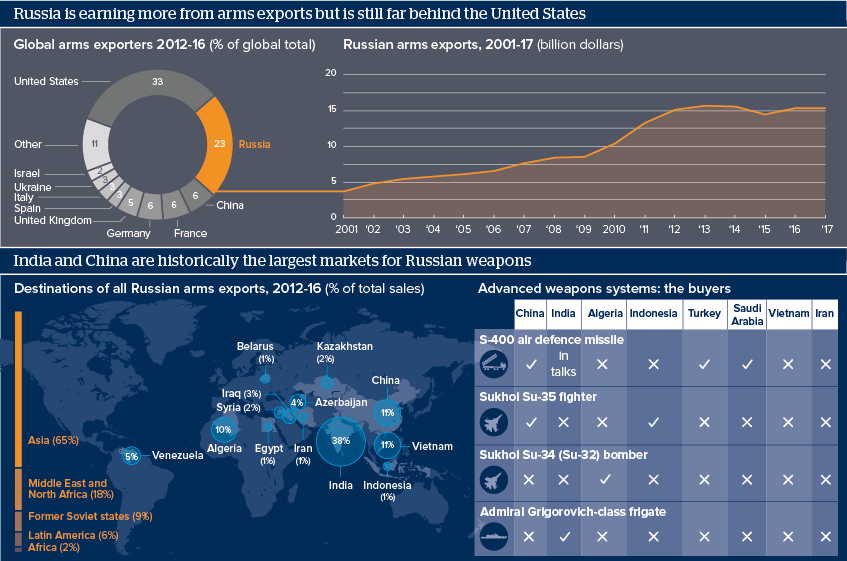Russian arms sales mix political aims with pragmatism
Moscow sells its best weapons to a select few but the rest are available to anyone who can afford it
Source: Stockholm International Peace Research Institute, CAST Centre for Analysis of Strategies and Technologies, Vedomosti, Russian First Channel TV, Lenta.ru
Outlook
Russian arms exports picked up after 2000 as domestic rearmament programmes generated competitive new designs. Exports support a defence sector which struggles despite large-scale state procurement. Arms sales complement foreign policy aims, and traditional customers such as China, India, Vietnam and Algeria have been joined by states where Russian engagement is more recent: Egypt, Turkey and Saudi Arabia.
Pragmatic calculations about clients’ ability to pay also count. Solvency as well as sanctions concerns mean that longstanding customer Tehran has not received the advanced S-400 air defence system offered to Ankara and Riyadh. Some customers in Africa and elsewhere are happy to buy less sophisticated arms that are adequate for their needs.
Impacts
- The Syrian conflict has showcased several advanced weapon types in action, exciting interest among potential buyers.
- Africa is a small but growing market: Uganda and Nigeria are the largest customers; others tend to buy refurbished equipment.
- Former Soviet states will buy almost entirely from Russia, and Collective Security Treaty Organisation members will get discount prices.
- India is stalling on development of a joint stealth fighter with Russia because of concerns about how advanced the technology is.
See also
- Russian arms sales challenged by rivals and sanctions - May 11, 2021
- Russia and China too ill-matched for defence alliance - Mar 23, 2021
- Russian arms procurement faces fiscal constraints - Mar 29, 2019
- Ballooning Russian arms group may not create savings - Nov 22, 2018
- China's sales to Russia mark a new trend in arms trade - Oct 29, 2018
- Russian courts Asia for imports and export sales - Oct 11, 2018
- US sanctions on Russia ratchet up with limited impact - Sep 10, 2018
- Russian non-hydrocarbon export growth faces challenges - Jun 28, 2018
- US sanctions may deter but not halt Russian arms sales - Apr 18, 2018
- Russia’s Africa focus will only be partial - Mar 29, 2018
- Russia accepts in-kind payment for Indonesia jet sale - Feb 15, 2018
- Russian arms sellers seek solvent and friendly clients - Jul 10, 2017
- More graphic analysis
